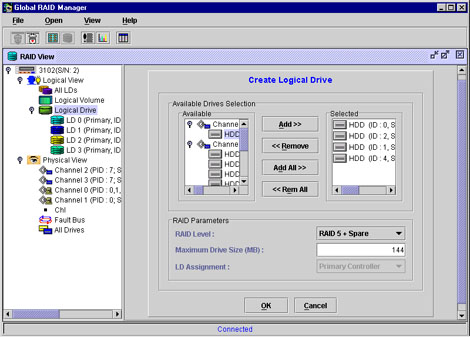|
|
| |
Remote Management

|
User-friendly
Graphical Interface runs on Windows2000, Windows-NT, Solaris, or any standard web browser.
Supports unlimited number of RAID managers which allows multiple controllers to be
managed/monitored concurrently.
"At a glance" monitoring of entire array status.
Designed to facilitate Network-wide RAID management.
Management of unlimited number of RAID Systems which allows multiple controllers to be
managed/monitored concurrently.
TCP/SNMP agents running on Windows2000, Windows-NT, Solaris, NetWare, SCO/UnixWare, Unix,
Linux, etc.
|

Standard GUI RAID Manager functions include:
* Support for the issuance of SNMP traps in
response to events that are posted by the controller.
* Examine and modify controller configuration
* View and monitor physical drive configuration/status
* Scan in new physical drives
* Create, delete, and monitor logical drive configuration/status
* Rebuild logical drive
* Define spare drives
* Create, delete, and partition logical volumes
* Map logical volume partitions to host channel SCSI-IDs/LUNs.
The deamon runs independently from the GUI RAID Management application:
* Severity level configuration setting for initiating a notification sequence.
* Configurable latency time between event occurrences and initial notification
sequence. This allows the local administrator time to cancel a notification.
* Notification via pager/telephone through local modem.
* Optional retry of notification until acknowledgement directly at console or
remotely over a LAN, Internet, or via modem.
* Configurable notification retry period that can be set to different values at
different times of the day.
* Notification via e-mail.
* Notification via broadcast over LAN.
* User-customizable broadcast message sent along with event description.
* Notification via fax through local fax/modem
* Custom broadcast message can be sent along with event description.
* Automatic retry if fax fails to transmit. Address book containing names, numbers,
e-mail addresses, groups/network broadcast addresses, and fax numbers to which
notifications can be sent. |
|
|
|
|
|